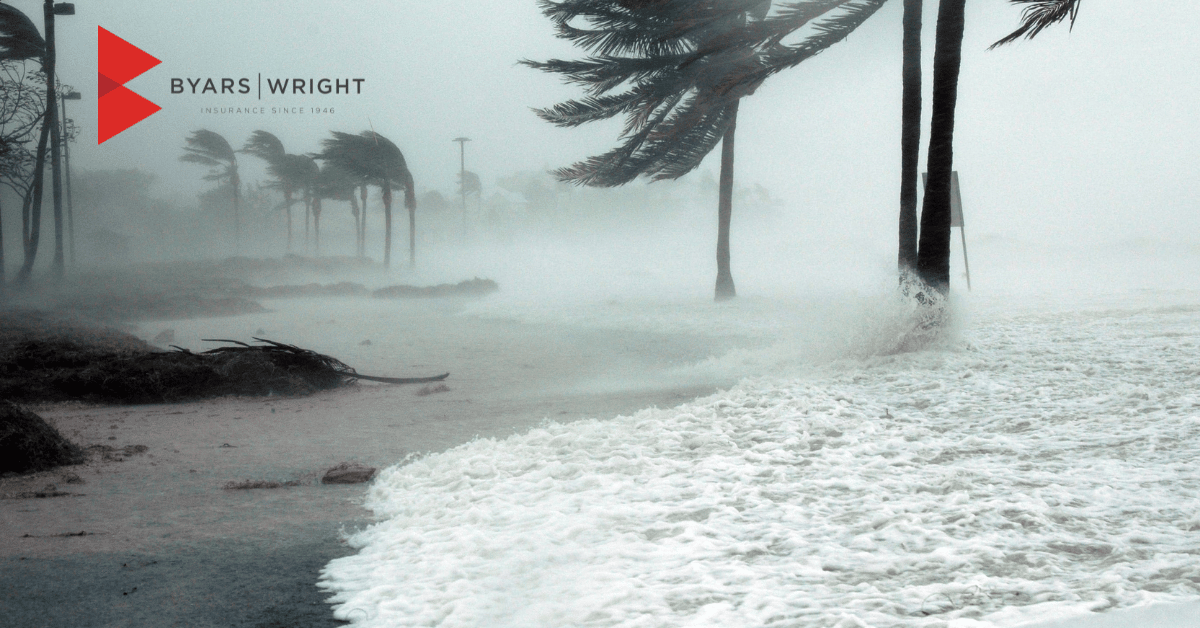
27 Sep Are You Prepared For A Hurricane?
Hurricanes are capable of producing winds in excess of 155 mph and causing catastrophic damage to coastlines and several hundred miles inland. Additionally, hurricanes can also lead to storm surges along the coast and cause extensive damage from heavy rainfall. Whether you live in a coastal area full-time or you own a second home on the Gulf Coast, you could be affected by hurricanes. Review the following guidance for tips on how you can prepare for a hurricane and how you can safely respond in the aftermath.
All Atlantic and Gulf of Mexico coastal areas are subject to hurricanes. Parts of the Southwest United States and the Pacific Coast also experience heavy rains and floods each year from hurricanes spawned off Mexico. The Atlantic hurricane season lasts from June to November, with the peak season from mid-August to late October. The Eastern Pacific hurricane season begins May 15 and ends November 30.
Before a Hurricane
To prepare for a hurricane, take the following measures:
- Build an emergency kit and make a family communications plan.
- Learn the elevation level of your property and whether the land is flood-prone. This will help you know how your property will be affected when a storm surge or tidal flooding are forecasted.
- Identify levees and dams in your area and determine whether they pose a hazard to you.
- Learn community hurricane evacuation routes and how to find higher ground. Determine where you would go and how you would get there if you needed to evacuate.
- Make plans to secure your property.
- Cover all of your home’s windows. Permanent storm shutters offer the best protection for windows. A second option is to board up windows with 5/8-inch marine plywood, cut to fit and ready to install. Tape does not prevent windows from breaking.
- Install straps or additional clips to securely fasten your roof to the frame structure. This will reduce roof damage.
- Be sure trees and shrubs around your home are well trimmed so they are more wind resistant.
- Clear loose and clogged rain gutters and downspouts.
- Reinforce your garage doors. If wind enters a garage, it can cause dangerous and expensive structural damage.
- Bring in all outdoor furniture, decorations, garbage cans and anything else that is not tied down.
- Determine how and where to secure your boat.
- Install a generator for emergencies.
- If you live in a high-rise building, prepare to take shelter on or below the 10th floor.
- Consider building a safe room.
Hurricanes cause heavy rains that can cause extensive flood damage in coastal and inland areas. Everyone is at risk and should consider flood insurance protection. Flood insurance is the only way to financially protect your property or business from flood damage.
Understand Hurricane Terminology
Familiarize yourself with these terms to help identify a hurricane hazard:
- Tropical cyclone—This is a warm-core, non-frontal, synoptic-scale cyclone, originating over tropical or subtropical waters, with organized deep convection and a closed surface wind circulation about a well-defined center. Once formed, a tropical cyclone is maintained by the extraction of heat energy from the ocean at high temperature and heat export at the low temperatures of the upper troposphere.
- Tropical depression—This is a tropical cyclone in which the maximum sustained surface wind speed (using the U.S. one-minute average) is 38 mph (33 knots) or less.
- Tropical storm—This is a tropical cyclone in which the maximum sustained surface wind speed (using the U.S. one-minute average) ranges from 39 mph (34 knots) to 73 mph (63 knots).
- Hurricane—This is a tropical cyclone in which the maximum sustained surface wind (using the U.S. one-minute average) is 74 mph (64 knots) or more.
- Storm surge—This is an abnormal rise in sea level accompanying a hurricane or other intense storm, and whose height is the difference between the observed level of the sea surface and the level that would have occurred in the absence of the cyclone. Storm surge is usually estimated by subtracting the normal or astronomic high tide from the observed storm tide. Storm surge can reach heights well over 20 feet and can span hundreds of miles of coastline.
- Storm tide—This is the actual level of seawater resulting from the astronomic tide combined with the storm surge.
- Hurricane warning—This is an announcement that hurricane conditions (sustained winds of 74 mph or higher) are expected somewhere within the specified area. Because hurricane preparedness activities become difficult once winds reach tropical storm force, the hurricane warning is issued 36 hours in advance of the anticipated onset of storm-force winds.
- Hurricane watch—This is an announcement that hurricane conditions (sustained winds of 74 mph or higher) are possible within the specified area. Because hurricane preparedness activities become difficult once winds reach tropical storm force, the hurricane watch is issued 48 hours in advance of the anticipated onset of storm-force winds.
- Tropical storm warning—This is an announcement that tropical storm conditions (sustained winds of 39 mph to 73 mph) are expected somewhere within the specified area within 36 hours.
- Tropical storm watch—This is an announcement that tropical storm conditions (sustained winds of 39 mph to 73 mph) are possible within the specified area within 48 hours.
During a Hurricane
If a hurricane is likely in your area, you should:
- Listen to the radio or TV for information.
- Secure your home, close storm shutters and secure outdoor objects or bring them indoors.
- Turn off utilities if instructed to do so. Otherwise, turn the refrigerator thermostat to its coldest setting and keep its doors closed.
- Turn off propane tanks.
- Avoid using the phone, except for serious emergencies.
- Moor your boat if time permits.
- Keep a supply of water for sanitary purposes, such as cleaning and flushing toilets. Fill the bathtub and other larger containers with water.
- Find out how to keep food safe during and after an emergency.
You should evacuate under the following conditions:
- If local authorities direct you to do so. Be sure to follow their instructions.
- If you live in a mobile home or temporary structure. These shelters are particularly hazardous during hurricanes, no matter how well-fastened to the ground.
- If you live in a high-rise building. Hurricane winds are stronger at higher elevations.
- If you live on the coast, on a floodplain, near a river or on an island waterway.
If you are unable to evacuate, go to your wind-safe room. If you do not have one, follow these guidelines:
- Stay indoors during the hurricane and away from windows and glass doors.
- Close all interior doors, and secure and brace external doors.
- Keep curtains and blinds closed. Do not be fooled if there is a lull; it could be the eye of the storm and winds will pick up again.
- Take refuge in a small interior room, closet or hallway on the lowest level.
- Lie on the floor under a table or another sturdy object.
- Avoid elevators.
After a Hurricane
- Continue listening to the radio or the local news for the latest updates.
- Stay alert for extended rainfall and subsequent flooding, even after the hurricane or tropical storm has ended.
- If you have become separated from your family, use your family communications plan or contact the American Red Cross at 1-800-RED-CROSS/1-800-733-2767 or visit the American Red Cross Safe and Well site: www.safeandwell.org.
- The American Red Cross also maintains a database to help you find family. Contact the local American Red Cross chapter where you are staying for information. Do not contact the chapter in the disaster area.
- If you evacuated, return home only when officials say it is safe.
- For those who have longer-term housing needs, the Federal Emergency Management Agency (FEMA) offers several types of assistance, including services and grants to help people repair their homes and find replacement housing. Apply for assistance or search for information about housing rental resources.
- Drive only if necessary and avoid flooded roads and washed-out bridges. Stay off the streets. If you must go out, watch for fallen objects including downed electrical wires, weakened walls, bridges, roads and sidewalks.
- Keep away from loose or dangling power lines and report them immediately to the power company.
- Walk carefully around the outside your home and check for loose power lines, gas leaks and structural damage before entering.
- Stay out of any building if you smell gas, or if floodwater remains around the building or your home has fire damage and the authorities have not declared it safe.
- Inspect your home for damage. Take pictures of damage, both of the building and its contents, for insurance purposes. If you have any doubts about safety, have your residence inspected by a qualified building inspector or structural engineer before entering.
- Use battery-powered flashlights in the dark. Do not use candles. Keep in mind that you should turn on the flashlight outside before entering, as the battery may produce a spark that could ignite leaking gas, if present.
- Watch your pets closely and keep them under your direct control. Watch out for wild animals, especially poisonous snakes. Use a stick to poke through debris.
- Avoid drinking or preparing food with tap water until you are sure it’s free of any contaminants.
- Check refrigerated food for spoilage. If in doubt, throw it out.
- Wear protective clothing and be cautious when cleaning up to avoid injury.
- Use the telephone only for emergency calls.
- Never use a generator inside homes, garages, crawlspaces, sheds or similar areas, even when using fans or opening doors and windows for ventilation. Deadly levels of carbon monoxide can quickly build up in these areas and can linger for hours, even after the generator has shut off.
Byars|Wright Insurance is here to help you and your loved-ones stay safe when disaster strikes. For further personal risk management guidance, connect or contact us today


